Richards Spur
Richards Spur | |
|---|---|
Geologic site | |
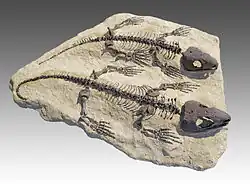 Artificially assembled Captorhinus aguti fossils found at Richards Spur | |
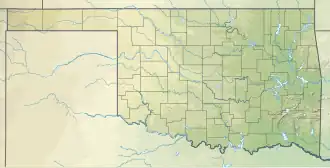 Richards Spur | |
| Coordinates: 34°46′N 98°24′W / 34.77°N 98.40°W | |
| Location | near Lawton, Oklahoma |
| Age | Artinskian (Early Permian, 289.7–283.8 Ma) |
Richards Spur is a Permian fossil locality located at the Dolese Brothers Limestone Quarry north of Lawton, Oklahoma. The locality preserves clay and mudstone fissure fills of a karst system eroded out of Ordovician limestone and dolomite, with the infilling dating to the Artinskian stage of the early Permian (Cisuralian), around 289 to 286 million years ago. Fossils of terrestrial animals are abundant and well-preserved, representing one of the most diverse Paleozoic tetrapod communities known.[1][2] A common historical name for the site is Fort Sill, in reference to the nearby military base.[3] Fossils were first reported at the quarry by workers in 1932, spurring a wave of collecting by local and international geologists. Early taxa of interest included the abundant reptile Captorhinus[4][5] and microsaurs such as Cardiocephalus and Euryodus.[3] Later notable discoveries include Doleserpeton (one of the most lissamphibian-like Paleozoic tetrapods),[6] the most diverse assortment of parareptiles in the Early Permian,[7] and the rare early diapsid Orovenator.[8]
Geology
The caves of Richards Spur formed in the Ordovician-age Arbuckle Limestone, which was uplifted, exposed, and tilted into a vertical orientation within the Pennsylvanian and Permian. In the early Permian, a karst system formed within the limestone, complete with caves containing speleotherms (stalagmites, stalactites, cave popcorn, etc.) made of calcite. Most of the karsts are narrow, 40–60 cm (16-24 inches) in width, and vertically oriented. Due to active mining at the site constantly destroying and exposing new layers, the layout of the system has not been recorded. Most of the Permian infill is discarded in the quarry's waste dumps without sedimentological and stratigraphic data, hampering studies into those aspects of the locality. However, it is known that the lower sections of the system (25 meters or 82 feet below the surface) lacks fossil material.[1]

Many of the fossils of Richards Spur were found in soft calcareous claystone or conglomerate. They likely ended up in the caves as a result of water runoff from the surface, as indicated by the presence of surface minerals such as quartz, kaolinite, and sulfides among the fossils. Individual organisms may have been already disarticulated by scavenging or decomposition on the surface, decomposed within the caves after the fresh corpse had been washed in, or even died within the caves after becoming trapped. Organisms which became disarticulated on the surface experienced more wear and erosion on their fossils, induced by exposure to the elements and transportation by water within and/or outside the karst system. On the other hand, recently deceased or living organism would have been more articulated due to their decomposition occurring in the more stable cave environment, with their tendons keeping their individual bones in place prior to fossilization.[1]
The most complete fossils were encased in a residue which was almost completely calcite, indicating that the cave structures precipitated around their skeletons. The caves likely had to have been submerged in water (or at least persistently humid) for active speleotherm formation, and therefore this mode of spectacular preservation, to have been possible. Some fossils are encrusted by pyrite, indicating the presence of anoxic fluids or diagenesis in the systems at some point. Most (but not all) fossils are stained a dark color by seepage of hydrocarbons into the deposits. These assorted biochemical conditions are the likely cause of unusually variable Carbon isotope values found within different preserved speleotherms.[1]
Paleoenvironment
Isotope analysis of preserved speleotherms shows several regular fluctuations in δ18O levels within a time span of 1-20 thousand years. Similar fluctuations in modern low-latitude environments are considered to be indicative of strong variation in precipitation between wet and arid periods on the scales of centuries or millennia. Some trace elements agree with this data, as Barium and Phosphorus concentrations increase with higher δ18O (drier periods); this is explained by increased incorporation of dust and seafoam in drier, windier periods, as demonstrated by climatological analyses in a modern cave system in Israel.[9][1]
Other than exceedingly rare fragments of xenacanthids and eryopoids, aquatic animals are practically absent from Richards Spur. Although amphibians are common at the site, most of them are terrestrially-adapted taxa such as dissorophoids, microsaurs, and seymouriamorphs. This is in strong contrast to contemporary floodplain environments in Oklahoma and Texas, which have abundant fossils of aquatic animals like Eryops and Diplocaulus, along with large lowland amniotes like Edaphosaurus. As a result, the site is considered to represent animals living in a drier environment upland from the humid floodplains which preserve most of the Permian red beds. The only other productive Early Permian geological locale commonly considered to preserve an upland community is the Tambach Formation of Germany.[10][11][2]
Age
The unique preservational environment of Richards Spur precludes geological stratigraphy. Based on the faunal composition (particularly the abundance of Captorhinus aguti, Cardiocephalus, and Euryodus), Richards Spur has been considered roughly equivalent in age to the Arroyo Formation (Lower Clear Fork) of Texas.[3][10][12] In Oklahoma, the equivalent may be the upper Garber Formation or lower Hennessey Formation.[13] The South Grandfield site of the Hennessey Formation is an example of a more typical Oklahoman fossil locale which has similar captorhinid and microsaur taxa to Richards Spur.[2] To determine the absolute age of the Richards Spur deposits, the speleotherm studied for the Oxygen isotope and trace element analyses was also sampled for Uranium-Lead dating. It was determined that the speleotherm was formed between 289.68 and 288.32 million years ago. This time period was originally stated to be Sakmarian in age,[9] but after a later refinement to the ICS timescale, it was specified as belonging to the early Artinskian. Two more speleotherms studied later gave date ranges of 283.8 to 289.6 Ma, and 286.0 to 286.4 Ma, indicating that the locality was deposited over several million years.[1]
Paleobiota
Temnospondyls
Large Eryops-like fragments are rare at the site.[11] The site has also produced extensive postcranial remains, including partial skeletons, belonging to large unnamed dissorophoids.[2][14][15]
| Temnospondyls of Richards Spur | |||
|---|---|---|---|
| Genus | Species | Notes | Images |
| Acheloma | A. cryptatheria[16] | A trematopid. | |
| A. dunni[17] | A trematopid, potentially a junior synonym of Acheloma cumminsi.[18] | 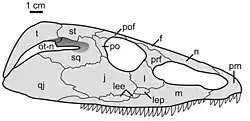 | |
| A. sp. | Juvenile trematopids similar to Acheloma and Phonerpeton.[19][20] | ||
| Aspidosaurus | A. chiton | A dissorophid.[15][21] | |
| Cacops | C. morrisi[22] | A dissorophid.[23][15] | 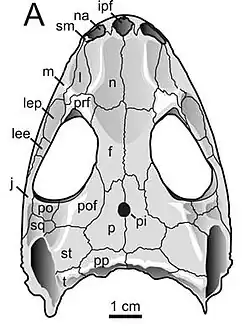 |
| C. woehri[24] | A dissorophid.[25][15] |  | |
| Dissorophus | D. multicinctus | A dissorophid.[15] | |
| Doleserpeton[6] | D. annectens | An amphibamid, potentially one of the closest Permian-age relatives of living amphibians (lissamphibians).[26][27][28] | |
| Pasawioops[29] | P. mayi | A micropholid amphibamiform.[30][31] | |
| Tersomius | T. dolesensis[30] | A micropholid amphibamiform. | |
Recumbirostrans
Recumbirostran microsaurs are typically classified as amphibians (non-amniote tetrapods), but some studies, starting in 2017,[32] suggest that they may instead be a group of sauropsids (amniotes related to modern reptiles).
| Recumbirostran microsaurs of Richards Spur | |||
|---|---|---|---|
| Genus | Species | Notes | Images |
| Cardiocephalus | C. peabodyi | A gymnarthrid.[3][33] | |
| Euryodus | E. sp. | A gymnarthrid.[3][33][34] The Richards Spur material is not referable to any existing Euryodus species.[34] Some Richards Spur specimens of the captorhinid Opisthodontosaurus carrolli were originally mistaken as E. primus.[35] | |
| Llistrofus[33] | L. pricei | A hapsidopareiid.[36][37] Llistrofus is potentially a junior synonym of Hapsidopareion.[38] | |
| Nannaroter[39] | N. mckinziei | An ostodolepid.[40] | 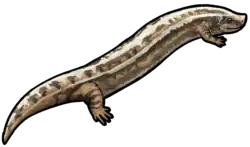 |
Other amphibians
| Other amphibians of Richards Spur | |||
|---|---|---|---|
| Genus | Species | Notes | Images |
| Seymouria | S. sp. | A seymouriamorph.[10][41][42][43][44] | 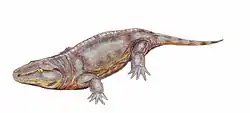 |
| Sillerpeton[45] | S. permianum | A legless phlegethontiid aistopod, only represented by a few braincases and vertebrae.[46] | |
Synapsids
The family Varanopidae are typically classified as synapsids (amniotes related to mammals), but some studies, starting in 2018,[47] suggest that they may instead be a group of sauropsids (amniotes related to modern reptiles). One varanopid specimen preserves fused tail vertebrae, a sign of metabolic bone disease similar to Paget's disease.[48]
| Putative synapsids of Richards Spur | |||
|---|---|---|---|
| Genus | Species | Notes | Images |
| Arisierpeton[49] | A. simplex | A caseid. |  |
| Basicranodon[50] | B. fortsillensis | A nomen dubium based on braincase fragments similar to Mesenosaurus and Mycterosaurus.[51][52] | |
| Dimetrodon | D. sp. | A sphenacodontid. Dimetrodon is very rare at Richards Spur, represented by a single neural spine fragment.[53] Sphenacodontid jaw fragments are also found at the site.[54] | 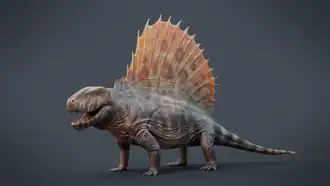 |
| Mesenosaurus | M. efremovi[52] | A varanopid.[55][56] | |
| Mycterosaurus | M. longiceps | A varanopid.[51][57] | |
| Oromycter[58] | O. dolesorum | A caseid. | |
| Thrausmosaurus[59] | T. serratidens | A nomen dubium named for varanopid jaw fragments initially mistaken for sphenacodontid remains.[54] | |
| Varanops | V. brevirostris | A varanopid.[12][57][60] | 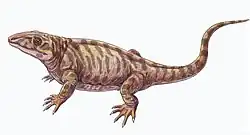 |
Sauropsids
"Parareptiles" are a set of early sauropsids (amniotes related to modern reptiles) which are traditionally classified as a clade (a group with a single shared ancestor), but some studies, starting in 2020,[61] suggest that they may instead be a collection of various unrelated early reptiles.[47] The family Captorhinidae are typically classified as sauropsids, but some studies, starting in 2022,[62] suggest that they may instead be outside of the crown group of amniotes.
Several juvenile captorhinid tail vertebrae preserve fracture planes, allowing the tail to drop off in a process known as caudal autotomy, similar to some modern lizards.[63]
| Putative sauropsids of Richards Spur | |||
|---|---|---|---|
| Genus | Species | Notes | Images |
| Abyssomedon[64] | A. williamsi | A nyctiphruretid procolophonian. | 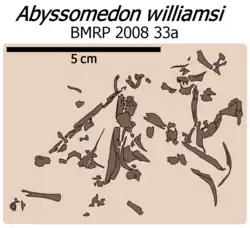 |
| Baeotherates[65] | B. fortsillensis | A captorhinid.[66] | |
| Bolosaurus | B. grandis[67] | A bolosaurid "parareptile".[68] | |
| Bolterpeton[69] | B. carrolli | A junior synonym of Delorhynchus, initially misidentified as a microsaur jaw.[70] | |
| Captorhinus | C. aguti | A captorhinid.[5][71][13][72][73][74][75][76] | 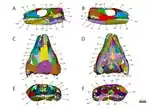 |
| C. kierani[77] | A captorhinid.[78] | 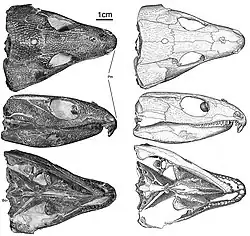 | |
| C. magnus[79] | A captorhinid.[78] |  | |
| Colobomycter[80] | C. pholeter | An acleistorhinid "parareptile".[81][82][83][7] | 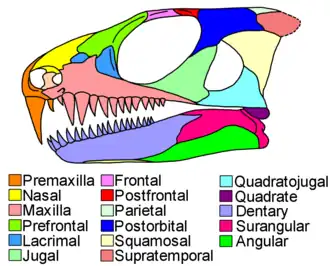 |
| C. vaughni[84] | An acleistorhinid "parareptile". | ||
| Delorhynchus[59] | D. cifellii[85] | An acleistorhinid "parareptile".[86][87][70][88] | |
| D. multidentatus[89] | An acleistorhinid "parareptile". | ||
| D. priscus | An acleistorhinid "parareptile".[85] | ||
| Feeserpeton[90] | F. oklahomensis | An acleistorhinid "parareptile".[91] |  |
| Klastomycter[92] | K. conodentatus | An acleistorhinid "parareptile". | |
| Labidosauriscus[66] | L. richardi | A captorhinid. | |
| Maiothisavros[93] | M. dianeae | A basal neodiapsid. | |
| Microleter[94] | M. mckinzieorum | An early sauropsid, usually regarded as a "parareptile". | 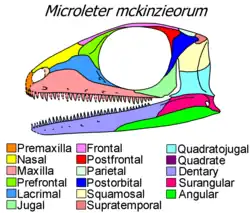 |
| Opisthodontosaurus[35] | O. carrolli | A captorhinid.[95] |  |
| Orovenator[8] | O. mayorum | A basal neodiapsid with similarities to varanopids.[47] | 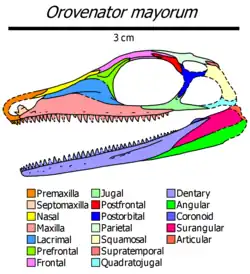 |
Invertebrates
Fragments of arthropod cuticle have been found stuck among the palatal teeth of Delorhynchus cifellii.[86][85]
| Invertebrates of Richards Spur | |||
|---|---|---|---|
| Genus | Species | Notes | Images |
| Dolesea[96] | D. subtila | An indeterminate millipede. | |
| Karstiulus[96] | K. fortsillensis | A xyloiuloid millipede. | |
| Oklahomasoma[96] | O. richardsspurense | A juliform millipede. | |
References
- ^ a b c d e f MacDougall, Mark J.; Tabor, Neil J.; Woodhead, Jon; Daoust, Andrew R.; Reisz, Robert R. (2017-06-01). "The unique preservational environment of the Early Permian (Cisuralian) fossiliferous cave deposits of the Richards Spur locality, Oklahoma". Palaeogeography, Palaeoclimatology, Palaeoecology. 475: 1–11. Bibcode:2017PPP...475....1M. doi:10.1016/j.palaeo.2017.02.019. ISSN 0031-0182.
- ^ a b c d Sullivan, Corwin; Reisz, Robert R.; May, William J. (2000-09-25). "Large dissorophoid skeletal elements from the Lower Permian Richards Spur Fissures, Oklahoma, and their paleoecological implications". Journal of Vertebrate Paleontology. 20 (3): 456–461. doi:10.1671/0272-4634(2000)020[0456:LDSEFT]2.0.CO;2. ISSN 0272-4634. S2CID 140709673.
- ^ a b c d e Gregory, J.T.; Peabody, Frank E.; Price, Llewellyn I. (1956). "Revision of the Gymnarthridae: American Permian microsaurs". Yale Peabody Museum Bulletin. 10: 1–77.
- ^ Price, L.I. (1935). "Notes on the brain case of Captorhinus". Proceedings of the Boston Society of Natural History. 40 (7): 377–386.
- ^ a b Olson, Everett Claire (29 July 1954). "Fauna of the Vale and Choza; 9. Captorhinomorpha". Fieldiana Geology. 10 (19): 211–218.
- ^ a b Bolt, J. R. (14 November 1969). "Lissamphibian origins: possible protolissamphibian from the Lower Permian of Oklahoma". Science. 166 (3907): 888–891. Bibcode:1969Sci...166..888B. doi:10.1126/science.166.3907.888. ISSN 0036-8075. PMID 17815754. S2CID 10813454.
- ^ a b Macdougall, Mark J.; Scott, Diane; Modesto, Sean P.; Williams, Scott A.; Reisz, Robert R. (2017-07-01). "New material of the reptile Colobomycter pholeter (Parareptilia: Lanthanosuchoidea) and the diversity of reptiles during the Early Permian (Cisuralian)". Zoological Journal of the Linnean Society. 180 (3): 661–671. doi:10.1093/zoolinnean/zlw012. ISSN 0024-4082.
- ^ a b Reisz, Robert R.; et al. (2011). "A new Early Permian reptile and its significance in early diapsid evolution". Proceedings of the Royal Society B. 278 (1725): 3731–3737. doi:10.1098/rspb.2011.0439. PMC 3203498. PMID 21525061.
- ^ a b Woodhead, Jon; Reisz, Robert; Fox, David; Drysdale, Russell; Hellstrom, John; Maas, Roland; Cheng, Hai; Edwards, R. Lawrence (May 2010). "Speleothem climate records from deep time? Exploring the potential with an example from the Permian". Geology. 38 (5): 455–458. Bibcode:2010Geo....38..455W. doi:10.1130/G30354.1. hdl:1959.13/931960. ISSN 0091-7613.
- ^ a b c Sullivan, Corwin; Reisz, Robert R (1999-08-21). "First record of Seymouria (Vertebrata: Seymouriamorpha) from Early Permian fissure fills at Richards Spur, Oklahoma". Canadian Journal of Earth Sciences. 36 (8): 1257–1266. Bibcode:1999CaJES..36.1257S. doi:10.1139/e99-035. ISSN 0008-4077.
- ^ a b Olson, Everett C. (1991-03-28). "An eryopid (Amphibia: Labyrinthodontia) from the Fort Sill fissures, Lower Permian, Oklahoma". Journal of Vertebrate Paleontology. 11 (1): 130–132. Bibcode:1991JVPal..11..130O. doi:10.1080/02724634.1991.10011379. ISSN 0272-4634.
- ^ a b Maddin, Hillary C.; Evans, David C.; Reisz, Robert R. (2006-12-11). "An Early Permian varanodontine varanopid (Synapsida: Eupelycosauria) from the Richards Spur locality, Oklahoma" (PDF). Journal of Vertebrate Paleontology. 26 (4): 957–966. doi:10.1671/0272-4634(2006)26[957:AEPVVS]2.0.CO;2. ISSN 0272-4634. S2CID 130455511.
- ^ a b Holmes, Robert (1977). "The osteology and musculature of the pectoral limb of small captorhinids". Journal of Morphology. 152 (1): 101–140. Bibcode:1977JMorp.152..101H. doi:10.1002/jmor.1051520107. ISSN 1097-4687. PMID 30253636. S2CID 52824069.
- ^ Gee, Bryan M.; Reisz, Robert R. (2018-03-22). "Postcrania of large dissorophid temnospondyls from Richards Spur, Oklahoma". Fossil Record. 21 (1): 79–91. Bibcode:2018FossR..21...79G. doi:10.5194/fr-21-79-2018. ISSN 2193-0066.
- ^ a b c d e Gee, Bryan M.; Bevitt, Joseph J.; Reisz, Robert R. (2019-07-30). "Dissorophid diversity at the early Permian cave system near Richards Spur, Oklahoma, USA". Palaeontologia Electronica. 22 (2): 976. Bibcode:2019PalEl..22..976G. doi:10.26879/976. ISSN 1094-8074.
- ^ Arias, Adrian F. Osterling; Mooney, Ethan D.; Bevitt, Joseph J.; Reisz, Robert R. (2024-10-17). "A new trematopid from the lower Permian of Oklahoma and new insights into the genus Acheloma". PLOS ONE. 19 (10): e0309393. Bibcode:2024PLoSO..1909393O. doi:10.1371/journal.pone.0309393. ISSN 1932-6203. PMC 11486393. PMID 39418236.
- ^ Polley, Brendan P.; Reisz, Robert R. (2011-04-01). "A new Lower Permian trematopid (Temnospondyli: Dissorophoidea) from Richards Spur, Oklahoma". Zoological Journal of the Linnean Society. 161 (4): 789–815. doi:10.1111/j.1096-3642.2010.00668.x. hdl:1807/18982. ISSN 0024-4082.
- ^ Gee, Bryan M (2020-08-20). "Size matters: the effects of ontogenetic disparity on the phylogeny of Trematopidae (Amphibia: Temnospondyli)". Zoological Journal of the Linnean Society. 190 (1): 79–113. doi:10.1093/zoolinnean/zlz170. ISSN 0024-4082.
- ^ Maddin, Hillary C.; Reisz, Robert R.; Anderson, Jason S. (2010). "Evolutionary development of the neurocranium in Dissorophoidea (Tetrapoda: Temnospondyli), an integrative approach". Evolution & Development. 12 (4): 393–403. doi:10.1111/j.1525-142X.2010.00426.x. ISSN 1520-541X. PMID 20618435.
- ^ Gee, Bryan M.; Bevitt, Joseph J.; Reisz, Robert R. (2019-03-12). "A Juvenile Specimen of the Trematopid Acheloma From Richards Spur, Oklahoma and Challenges of Trematopid Ontogeny". Frontiers in Earth Science. 7 38. Bibcode:2019FrEaS...7...38G. doi:10.3389/feart.2019.00038. ISSN 2296-6463.
- ^ Gee, Bryan M; Mann, Arjan; Sues, Hans-Dieter (2025-07-01). "A reassessment of Aspidosaurus chiton Broili, 1904 (Temnospondyli: Dissorophoidea) based on a new skeleton from the early Permian of Texas". Zoological Journal of the Linnean Society. 204 (3): zlaf046. doi:10.1093/zoolinnean/zlaf046. ISSN 0024-4082.
- ^ Reisz, Robert R.; Schoch, Rainer R.; Anderson, Jason S. (2009). "The armoured dissorophid Cacops from the Early Permian of Oklahoma and the exploitation of the terrestrial realm by amphibians". Naturwissenschaften. 96 (7): 789–796. Bibcode:2009NW.....96..789R. doi:10.1007/s00114-009-0533-x. ISSN 0028-1042. PMID 19347261.
- ^ Gee, Bryan M.; Reisz, Robert R. (2018-03-04). "Cranial and postcranial anatomy of Cacops morrisi, a eucacopine dissorophid from the early Permian of Oklahoma". Journal of Vertebrate Paleontology. 38 (2): e1433186. Bibcode:2018JVPal..38E3186G. doi:10.1080/02724634.2018.1433186. ISSN 0272-4634. S2CID 90120528.
- ^ Fröbisch, Nadia B.; Reisz, Robert R. (2012-01-01). "A new species of dissorophid (Cacops woehri) from the Lower Permian Dolese Quarry, near Richards Spur, Oklahoma". Journal of Vertebrate Paleontology. 32 (1): 35–44. Bibcode:2012JVPal..32...35F. doi:10.1080/02724634.2012.633586. ISSN 0272-4634. S2CID 131513990.
- ^ Fröbisch, N. B.; Brar, A.; Reisz, R. R. (2015-01-27). "New specimen of Cacops woehri indicates differences in the ontogenetic trajectories among cacopine dissorophids". Fossil Record. 18 (1): 73–80. Bibcode:2015FossR..18...73F. doi:10.5194/fr-18-73-2015. ISSN 2193-0066.
- ^ Sigurdsen, Trond (2008-12-01). "The otic region of Doleserpeton (Temnospondyli) and its implications for the evolutionary origin of frogs". Zoological Journal of the Linnean Society. 154 (4): 738–751. doi:10.1111/j.1096-3642.2008.00459.x. ISSN 0024-4082.
- ^ Sigurdsen, Trond; Bolt, John R. (2010-09-01). "The Lower Permian amphibamid Doleserpeton (Temnospondyli: Dissorophoidea), the interrelationships of amphibamids, and the origin of modern amphibians". Journal of Vertebrate Paleontology. 30 (5): 1360–1377. Bibcode:2010JVPal..30.1360S. doi:10.1080/02724634.2010.501445. ISSN 0272-4634.
- ^ Gee, Bryan M.; Haridy, Yara; Reisz, Robert R. (2020). "Histological skeletochronology indicates developmental plasticity in the early Permian stem lissamphibian Doleserpeton annectens". Ecology and Evolution. 10 (4): 2153–2169. Bibcode:2020EcoEv..10.2153G. doi:10.1002/ece3.6054. ISSN 2045-7758. PMC 7042763. PMID 32128146.
- ^ Fröbisch, Nadia B.; Reisz, Robert R. (2008-12-12). "A new Lower Permian amphibamid (Dissorophoidea, Temnospondyli) from the fissure fill deposits near Richards Spur, Oklahoma". Journal of Vertebrate Paleontology. 28 (4): 1015–1030. Bibcode:2008JVPal..28.1015F. doi:10.1671/0272-4634-28.4.1015. ISSN 0272-4634. S2CID 128698929.
- ^ a b Anderson, Jason S.; Bolt†, John R. (2013-05-01). "New information on amphibamids (Tetrapoda, Temnospondyli) from Richards Spur (Fort Sill), Oklahoma". Journal of Vertebrate Paleontology. 33 (3): 553–567. Bibcode:2013JVPal..33..553A. doi:10.1080/02724634.2013.726676. ISSN 0272-4634. S2CID 86122122.
- ^ Gee, Bryan M.; Haridy, Yara; Reisz, Robert R. (2017-08-22). "Histological characterization of denticulate palatal plates in an Early Permian dissorophoid". PeerJ. 5 e3727. doi:10.7717/peerj.3727. ISSN 2167-8359. PMC 5571816. PMID 28848692.
- ^ Jason D. Pardo; Matt Szostakiwskyj; Per E. Ahlberg; Jason S. Anderson (2017). "Hidden morphological diversity among early tetrapods". Nature. 546 (7660): 642–645. Bibcode:2017Natur.546..642P. doi:10.1038/nature22966. hdl:1880/113382. PMID 28636600. S2CID 2478132.
- ^ a b c Carroll, R. L.; Gaskill, P. (1978). "The Order Microsauria". Memoirs of the American Philosophical Society. 126: 1–211. ISBN 9780871691262.
- ^ a b Gee, Bryan M.; Bevitt, Joseph J.; Reisz, Robert R. (2021). "Computed tomographic analysis of the cranium of the early Permian recumbirostran 'microsaur' Euryodus dalyae reveals new details of the braincase and mandible". Papers in Palaeontology. 7 (2): 721–749. Bibcode:2021PPal....7..721G. doi:10.1002/spp2.1304. ISSN 2056-2802.
- ^ a b Reisz, R. R.; LeBlanc, Aaron R. H.; Sidor, Christian A.; Scott, Diane; May, William (2015-08-20). "A new captorhinid reptile from the Lower Permian of Oklahoma showing remarkable dental and mandibular convergence with microsaurian tetrapods". The Science of Nature. 102 (9): 50. Bibcode:2015SciNa.102...50R. doi:10.1007/s00114-015-1299-y. ISSN 1432-1904. PMID 26289932. S2CID 17161972.
- ^ Bolt, John R.; Rieppel, Olivier (2009). "The holotype skull of Llistrofus pricei Carroll and Gaskill, 1978 (Microsauria: Hapsidopareiontidae)". Journal of Paleontology. 83 (3): 471–483. Bibcode:2009JPal...83..471B. doi:10.1666/08-076.1. ISSN 0022-3360.
- ^ Gee, Bryan M.; Bevitt, Joseph J.; Garbe, Ulf; Reisz, Robert R. (2019-01-25). "New material of the 'microsaur' Llistrofus from the cave deposits of Richards Spur, Oklahoma and the paleoecology of the Hapsidopareiidae". PeerJ. 7 e6327. doi:10.7717/peerj.6327. ISSN 2167-8359. PMC 6348957. PMID 30701139.
- ^ Jenkins, Xavier A.; Sues, Hans-Dieter; Webb, Savannah; Schepis, Zackary; Peecook, Brandon R.; Mann, Arjan (2025). "The recumbirostran Hapsidopareion lepton from the early Permian (Cisuralian: Artinskian) of Oklahoma reassessed using HRμCT, and the placement of Recumbirostra on the amniote stem". Papers in Palaeontology. 11 (1): e1610. doi:10.1002/spp2.1610. ISSN 2056-2802.
- ^ Anderson, Jason S.; Scott, Diane; Reisz, Robert R. (2009-06-12). "Nannaroter mckinziei, a new ostodolepid 'microsaur' (Tetrapoda, Lepospondyli, Recumbirostra) from the Early Permian of Richards Spur (Ft. Sill), Oklahoma". Journal of Vertebrate Paleontology. 29 (2): 379–388. Bibcode:2009JVPal..29..379A. doi:10.1671/039.029.0222. ISSN 0272-4634. S2CID 130420068.
- ^ MacDougall, Mark J.; Seeger, Robert; Gee, Bryan; Ponstein, Jasper; Jansen, Maren; Scott, Diane; Bevitt, Joseph J.; Reisz, Robert R.; Fröbisch, Jörg (2021-09-22). "Revised Description of the Early Permian Recumbirostran "Microsaur" Nannaroter mckinziei Based on New Fossil Material and Computed Tomographic Data". Frontiers in Ecology and Evolution. 9 739316. Bibcode:2021FrEEv...939316M. doi:10.3389/fevo.2021.739316. ISSN 2296-701X.
- ^ Bazzana, Kayla D.; Gee, Bryan M.; Bevitt, Joseph J.; Reisz, Robert R. (2019-09-03). "Neurocranial anatomy of Seymouria from Richards Spur, Oklahoma". Journal of Vertebrate Paleontology. 39 (5): e1694535. Bibcode:2019JVPal..39E4535B. doi:10.1080/02724634.2019.1694535. ISSN 0272-4634.
- ^ Bazzana, Kayla D.; Gee, Bryan M.; Bevitt, Joseph J.; Reisz, Robert R. (2020-03-10). "Postcranial anatomy and histology of Seymouria, and the terrestriality of seymouriamorphs". PeerJ. 8 e8698. doi:10.7717/peerj.8698. ISSN 2167-8359. PMC 7069408. PMID 32195050.
- ^ Maho, Tea; Reisz, Robert R. (2022). "Dental anatomy and replacement patterns in the early Permian stem amniote, Seymouria". Journal of Anatomy. 241 (3): 628–634. doi:10.1111/joa.13715. ISSN 0021-8782. PMC 9358742. PMID 35762030.
- ^ Bazzana-Adams, Kayla D.; Evans, David C.; Bevitt, Joseph J.; Reisz, Robert R. (2023). "Neurosensory anatomy and function in Seymouria". Journal of Morphology. 284 (5) e21577. Bibcode:2023JMorp.284E1577B. doi:10.1002/jmor.21577. ISSN 0362-2525. PMID 36921082.
- ^ Lund, Richard (10 March 1978). "Anatomy and relationships of the family Phlegethontiidae (Amphibia, Aistopoda)". Annals of the Carnegie Museum. 47: 53–79. Bibcode:1978AnCM...47...53L. doi:10.5962/p.215819. S2CID 155937401.
- ^ Anderson, Jason S. (November 2002). "Revision of the aïstopod genus Phlegethontia (Tetrapoda: Lepospondyli)". Journal of Paleontology. 76 (6): 1029–1046. doi:10.1017/S0022336000057851. ISSN 0022-3360. S2CID 86187663.
- ^ a b c Ford, David P.; Benson, Roger B. J. (2018). "A redescription of Orovenator mayorum (Sauropsida, Diapsida) using high-resolution μCT, and the consequences for early amniote phylogeny". Papers in Palaeontology. 5 (2): 197–239. doi:10.1002/spp2.1236. ISSN 2056-2802. S2CID 92485505.
- ^ Haridy, Yara; Witzmann, Florian; Asbach, Patrick; Reisz, Robert R. (2019-08-07). "Permian metabolic bone disease revealed by microCT: Paget's disease-like pathology in vertebrae of an early amniote". PLOS ONE. 14 (8): e0219662. Bibcode:2019PLoSO..1419662H. doi:10.1371/journal.pone.0219662. ISSN 1932-6203. PMC 6685605. PMID 31390345.
- ^ Reisz, Robert R. (2019-04-11). "A small caseid synapsid, Arisierpeton simplex gen. et sp. nov., from the early Permian of Oklahoma, with a discussion of synapsid diversity at the classic Richards Spur locality". PeerJ. 7 e6615. doi:10.7717/peerj.6615. ISSN 2167-8359. PMC 6462398. PMID 30997285.
- ^ Vaughn, Peter Paul (1957). "A Pelycosaur with subsphenoidal teeth from the Lower Permian of Oklahoma". Journal of the Washington Academy of Sciences. 48 (2): 44–47. JSTOR 24533763.
- ^ a b Reisz, Robert R.; Wilson, Heather; Scott, Diane (1997). "Varanopseid synapsid skeletonal elements from Richards Spur, a Lower Permian fissure fill located near Fort Sill, Oklahoma" (PDF). Oklahoma Geology Notes. 57 (5): 160–170.
- ^ a b Maho, Sigi; Gee, Bryan M.; Reisz, Robert R. (23 October 2019). "A new varanopid synapsid from the early Permian of Oklahoma and the evolutionary stasis in this clade". Royal Society Open Science. 6 (10): 191297. Bibcode:2019RSOS....691297M. doi:10.1098/rsos.191297. PMC 6837192. PMID 31824730.
- ^ Brink, Kirstin S.; MacDougall, Mark J.; Reisz, Robert R. (2019-01-04). "Dimetrodon (Synapsida: Sphenacodontidae) from the cave system at Richards Spur, OK, USA, and a comparison of Early Permian–aged vertebrate paleoassemblages". The Science of Nature. 106 (1): 2. Bibcode:2019SciNa.106....2B. doi:10.1007/s00114-018-1598-1. ISSN 1432-1904. PMID 30610457. S2CID 57427089.
- ^ a b Evans, David C.; Maddin, Hillary C.; Reisz, Robert R. (2009). "A Re-Evaluation of Sphenacodontid Synapsid Material from the Lower Permian Fissure Fills Near Richards Spur, Oklahoma". Palaeontology. 52 (1): 219–227. Bibcode:2009Palgy..52..219E. doi:10.1111/j.1475-4983.2008.00837.x. ISSN 0031-0239.
- ^ Maho, Tea; Maho, Sigi; Scott, Diane; Reisz, Robert R. (2022-08-19). "Permian hypercarnivore suggests dental complexity among early amniotes". Nature Communications. 13 (1): 4882. Bibcode:2022NatCo..13.4882M. doi:10.1038/s41467-022-32621-5. ISSN 2041-1723. PMC 9391490. PMID 35986022.
- ^ Maho, Tea; Maho, Sigi; Bevitt, Joseph J.; Reisz, Robert R. (2024). "Size and shape heterodonty in the early Permian synapsid Mesenosaurus efremovi". Journal of Anatomy. 245 (1): 181–196. doi:10.1111/joa.14034. ISSN 1469-7580. PMC 11161827. PMID 38430000.
- ^ a b Huttenlocker, Adam K.; Shelton, Christen D. (2020-01-13). "Bone histology of varanopids (Synapsida) from Richards Spur, Oklahoma, sheds light on growth patterns and lifestyle in early terrestrial colonizers". Philosophical Transactions of the Royal Society B: Biological Sciences. 375 (1793): 20190142. doi:10.1098/rstb.2019.0142. PMC 7017428. PMID 31928198.
- ^ Reisz, Robert R. (2005-12-30). "Oromycter, a new caseid from the Lower Permian of Oklahoma". Journal of Vertebrate Paleontology. 25 (4): 905–910. doi:10.1671/0272-4634(2005)025[0905:OANCFT]2.0.CO;2. ISSN 0272-4634. S2CID 130056690.
- ^ a b Fox, Richard C. (1962). "Two New Pelycosaurs from the Lower Permian of Oklahoma". University of Kansas Publications, Museum of Natural History. 12 (6): 297–307.
- ^ Maho, Tea; Bevitt, Joseph J.; Reisz, Robert R. (2023-02-15). "New specimens of the early Permian apex predator Varanops brevirostris at Richards Spur, Oklahoma, with histological information about its growth pattern". PeerJ. 11 e14898. doi:10.7717/peerj.14898. ISSN 2167-8359. PMC 9938655. PMID 36819993.
- ^ Ford DP, Benson RB (January 2020). "The phylogeny of early amniotes and the affinities of Parareptilia and Varanopidae". Nature Ecology & Evolution. 4 (1): 57–65. doi:10.1038/s41559-019-1047-3. PMID 31900445. S2CID 209673326.
- ^ Simões, T. R.; Kammerer, C. F.; Caldwell, M. W.; Pierce, S. E. (2022). "Successive climate crises in the deep past drove the early evolution and radiation of reptiles". Science Advances. 8 (33): eabq1898. Bibcode:2022SciA....8.1898S. doi:10.1126/sciadv.abq1898. PMC 9390993. PMID 35984885.
- ^ LeBlanc, A. R. H.; MacDougall, M. J.; Haridy, Y.; Scott, D.; Reisz, R. R. (2018-03-05). "Caudal autotomy as anti-predatory behaviour in Palaeozoic reptiles". Scientific Reports. 8 (1): 3328. Bibcode:2018NatSR...8.3328L. doi:10.1038/s41598-018-21526-3. ISSN 2045-2322. PMC 5838224. PMID 29507301.
- ^ Mark J. MacDougall and Robert R. Reisz (2014). "The first record of a nyctiphruretid parareptile from the Early Permian of North America, with a discussion of parareptilian temporal fenestration". Zoological Journal of the Linnean Society. 172 (3): 616–630. doi:10.1111/zoj.12180.
- ^ W. J. May & Richard L. Cifelli (1998). "Baeotherates fortsillensis, A New Captorhinid Reptile from the Fort Sill Fissures, Lower Permian of Oklahoma" (PDF). Oklahoma Geology Notes. 58: 128–137.
- ^ a b Modesto, Sean P.; Scott, Diane; Reisz, Robert R. (2018). "A new small captorhinid reptile from the lower Permian of Oklahoma and resource partitioning among small captorhinids in the Richards Spur fauna". Papers in Palaeontology. 4 (2): 293–307. Bibcode:2018PPal....4..293M. doi:10.1002/spp2.1109. ISSN 2056-2802. S2CID 135306015.
- ^ Reisz, Robert R.; Barkas, Vaia; Scott, Diane (2002-03-14). "A new early Permian bolosaurid reptile from the Richards Spur Dolese Brothers Quarry, near Fort Sill, Oklahoma". Journal of Vertebrate Paleontology. 22 (1): 23–28. doi:10.1671/0272-4634(2002)022[0023:ANEPBR]2.0.CO;2. ISSN 0272-4634. S2CID 129050218.
- ^ Snyder, Adam J.; LeBlanc, Aaron R. H.; Jun, Chen; Bevitt, Joseph J.; Reisz, Robert R. (2020-05-13). "Thecodont tooth attachment and replacement in bolosaurid parareptiles". PeerJ. 8 e9168. doi:10.7717/peerj.9168. ISSN 2167-8359. PMC 7229766. PMID 32440377.
- ^ Anderson, Jason S.; Reisz, Robert R. (2003-04-14). "A new microsaur (Tetrapoda: Lepospondyli) from the Lower Permian of Richards Spur (Fort Sill), Oklahoma". Canadian Journal of Earth Sciences. 40 (4): 499–505. Bibcode:2003CaJES..40..499A. doi:10.1139/e02-066. ISSN 0008-4077.
- ^ a b Haridy, Yara; Macdougall, Mark J; Reisz, Robert R (2018-10-20). "The lower jaw of the Early Permian parareptile Delorhynchus, first evidence of multiple denticulate coronoids in a reptile". Zoological Journal of the Linnean Society. 184 (3): 791–803. doi:10.1093/zoolinnean/zlx085. ISSN 0024-4082.
- ^ Fox, Richard; Bowman, M. (1966). Osteology and Relationships of Captorhinus Aguti (Cope) (Reptilia: Captorhinomorpha). The University of Kansas Paleontological Institute. pp. 1–79.
- ^ Holmes, Robert B (2003). "The hind limb of Captorhinus aguti and the step cycle of basal amniotes". Canadian Journal of Earth Sciences. 40 (4): 515–526. Bibcode:2003CaJES..40..515H. doi:10.1139/e02-039. ISSN 0008-4077.
- ^ Reisz, Robert R.; MacDougall, Mark J.; LeBlanc, Aaron R. H.; Scott, Diane; Nagesan, Ramon S. (2020-06-22). "Lateralized Feeding Behavior in a Paleozoic Reptile". Current Biology. 30 (12): 2374–2378.e4. Bibcode:2020CBio...30E2374R. doi:10.1016/j.cub.2020.04.026. ISSN 0960-9822.
- ^ Abel, Pascal; Pommery, Yannick; Ford, David Paul; Koyabu, Daisuke; Werneburg, Ingmar (2022-05-18). "Skull Sutures and Cranial Mechanics in the Permian Reptile Captorhinus aguti and the Evolution of the Temporal Region in Early Amniotes". Frontiers in Ecology and Evolution. 10 841784. Bibcode:2022FrEEv..1041784A. doi:10.3389/fevo.2022.841784. ISSN 2296-701X.
- ^ Werneburg, Ingmar; Abel, Pascal (2022-03-10). "Modeling Skull Network Integrity at the Dawn of Amniote Diversification With Considerations on Functional Morphology and Fossil Jaw Muscle Reconstructions". Frontiers in Ecology and Evolution. 9 799637. Bibcode:2022FrEEv...999637W. doi:10.3389/fevo.2021.799637. ISSN 2296-701X.
- ^ Mooney, Ethan D.; Maho, Tea; Philp, R. Paul; Bevitt, Joseph J.; Reisz, Robert R. (2024-01-22). "Paleozoic cave system preserves oldest-known evidence of amniote skin". Current Biology. 34 (2): 417–426.e4. doi:10.1016/j.cub.2023.12.008. ISSN 0960-9822. PMID 38215745.
- ^ deBraga, Michael; Bevitt, Joseph J.; Reisz, Robert R. (2019-05-15). "A New Captorhinid From the Permian Cave System Near Richards Spur, Oklahoma, and the Taxic Diversity of Captorhinus at This Locality". Frontiers in Earth Science. 7 112. Bibcode:2019FrEaS...7..112D. doi:10.3389/feart.2019.00112. ISSN 2296-6463.
- ^ a b Bazzana, Kayla D.; Evans, David C.; Bevitt, Joseph J.; Reisz, Robert R. (2023). "Endocasts of the basal sauropsid Captorhinus reveal unexpected neurological diversity in early reptiles". The Anatomical Record. 306 (3): 552–563. doi:10.1002/ar.25100. ISSN 1932-8486. PMID 36240106.
- ^ Kissel, Richard A.; Dilkes, David W.; Reisz, Robert R. (2002-09-01). "Captorhinus magnus, a new captorhinid (Amniota: Eureptilia) from the Lower Permian of Oklahoma, with new evidence on the homology of the astragalus". Canadian Journal of Earth Sciences. 39 (9): 1363–1372. Bibcode:2002CaJES..39.1363K. doi:10.1139/e02-040. ISSN 0008-4077.
- ^ Vaughn, P. P. (1958). "On a new pelycosaur from the Lower Permian of Oklahoma, and on the origin of the family Caseidae". Journal of Paleontology. 32 (5): 981–991. JSTOR 1300717.
- ^ Modesto, Sean Patrick (1999-09-14). "Colobomycter pholeter from the Lower Permian of Oklahoma: a parareptile, not a protorothyridid". Journal of Vertebrate Paleontology. 19 (3): 466–472. Bibcode:1999JVPal..19..466M. doi:10.1080/02724634.1999.10011159. ISSN 0272-4634.
- ^ Modesto, Sean P.; Reisz, Robert R. (2008-09-12). "New material of Colobomycter pholeter, a small parareptile from the Lower Permian of Oklahoma". Journal of Vertebrate Paleontology. 28 (3): 677–684. doi:10.1671/0272-4634(2008)28[677:NMOCPA]2.0.CO;2. ISSN 0272-4634.
- ^ MacDougall, Mark J.; LeBlanc, Aaron R. H.; Reisz, Robert R. (2014-05-07). "Plicidentine in the Early Permian Parareptile Colobomycter pholeter, and Its Phylogenetic and Functional Significance among Coeval Members of the Clade". PLOS ONE. 9 (5): e96559. Bibcode:2014PLoSO...996559M. doi:10.1371/journal.pone.0096559. ISSN 1932-6203. PMC 4013015. PMID 24804680.
- ^ MacDougall, Mark J.; Modesto, Sean P.; Reisz, Robert R. (2016-09-02). "A new reptile from the Richards Spur locality, Oklahoma, U.S.A., and patterns of Early Permian parareptile diversification". Journal of Vertebrate Paleontology. 36 (5): e1179641. Bibcode:2016JVPal..36E9641M. doi:10.1080/02724634.2016.1179641. ISSN 0272-4634. S2CID 89333948.
- ^ a b c Reisz, Robert R.; Macdougall, Mark J.; Modesto, Sean P. (2014-07-29). "A new species of the parareptile genus Delorhynchus, based on articulated skeletal remains from Richards Spur, Lower Permian of Oklahoma". Journal of Vertebrate Paleontology. 34 (5): 1033–1043. Bibcode:2014JVPal..34.1033R. doi:10.1080/02724634.2013.829844. ISSN 0272-4634. S2CID 128459194.
- ^ a b Modesto, Sean P.; Scott, Diane M.; Reisz, Robert R. (2009). "Arthropod remains in the oral cavities of fossil reptiles support inference of early insectivory". Biology Letters. 5 (6): 838–840. doi:10.1098/rsbl.2009.0326. PMC 2827974. PMID 19570779.
- ^ Haridy, Yara; Macdougall, Mark J.; Scott, Diane; Reisz, Robert R. (2016-12-01). "Ontogenetic Change in the Temporal Region of the Early Permian Parareptile Delorhynchus cifellii and the Implications for Closure of the Temporal Fenestra in Amniotes". PLOS ONE. 11 (12): e0166819. Bibcode:2016PLoSO..1166819H. doi:10.1371/journal.pone.0166819. ISSN 1932-6203. PMC 5132164. PMID 27907071.
- ^ Rowe, Dylan C. T.; Bevitt, Joseph J.; Reisz, Robert R. (2023-08-22). "Skeletal anatomy of the early Permian parareptile Delorhynchus with new information provided by neutron tomography". PeerJ. 11 e15935. doi:10.7717/peerj.15935. ISSN 2167-8359. PMC 10452630. PMID 37637171.
- ^ Rowe, Dylan C. T.; Scott, Diane M.; Bevitt, Joseph J.; Reisz, Robert R. (2021). "Multiple Tooth-Rowed Parareptile From the Early Permian of Oklahoma". Frontiers in Earth Science. 9 709497: 740. Bibcode:2021FrEaS...9..740R. doi:10.3389/feart.2021.709497. ISSN 2296-6463.
- ^ Macdougall, Mark J.; Reisz, Robert (2012-09-01). "A new parareptile (Parareptilia, Lanthanosuchoidea) from the Early Permian of Oklahoma". Journal of Vertebrate Paleontology. 32 (5): 1018–1026. Bibcode:2012JVPal..32.1018M. doi:10.1080/02724634.2012.679757. ISSN 0272-4634. S2CID 86218618.
- ^ MacDougall, Mark J.; Winge, Anika; Ponstein, Jasper; Jansen, Maren; Reisz, Robert R.; Fröbisch, Jörg (2019-10-31). "New information on the early Permian lanthanosuchoid Feeserpeton oklahomensis based on computed tomography". PeerJ. 7 e7753. doi:10.7717/peerj.7753. ISSN 2167-8359. PMC 6825742. PMID 31687269.
- ^ Reisz, Robert R.; Rowe, Dylan C. T.; Bevitt, Joseph J. (2024-11-19). "Klastomycter conodentatus, gen et sp. nov., a small early Permian parareptile with conical teeth from Richards Spur, Oklahoma". PeerJ. 12 e18393. doi:10.7717/peerj.18393. ISSN 2167-8359. PMC 11583906. PMID 39583101.
- ^ Mooney, Ethan D.; Maho, Tea; Bevitt, Joseph J.; Reisz, Robert R. (2022-11-30). "An intriguing new diapsid reptile with evidence of mandibulo-dental pathology from the early Permian of Oklahoma revealed by neutron tomography". PLOS ONE. 17 (11): e0276772. Bibcode:2022PLoSO..1776772M. doi:10.1371/journal.pone.0276772. ISSN 1932-6203. PMC 9710763. PMID 36449456.
- ^ Linda A. Tsuji; Johannes Muller; Robert R. Reisz (2010). "Microleter mckinzieorum gen. et sp. nov. from the Lower Permian of Oklahoma: the basalmost parareptile from Laurasia". Journal of Systematic Palaeontology. 8 (2): 245–255. Bibcode:2010JSPal...8..245T. doi:10.1080/14772010903461099. S2CID 129529082.
- ^ Haridy, Yara; LeBlanc, Aaron R. H.; Reisz, Robert R. (2018). "The Permian reptile Opisthodontosaurus carrolli: a model for acrodont tooth replacement and dental ontogeny". Journal of Anatomy. 232 (3): 371–382. doi:10.1111/joa.12754. ISSN 1469-7580. PMC 5807956. PMID 29210080.
- ^ a b c Hannibal, Joseph T.; May, William J. (2021). "Permian millipedes from the Fort Sill fissures of southwestern Oklahoma, with comments on allied taxa and millipedes preserved in karstic environments". Journal of Paleontology. 95 (3): 586–600. Bibcode:2021JPal...95..586H. doi:10.1017/jpa.2020.100. ISSN 0022-3360.
.jpg)